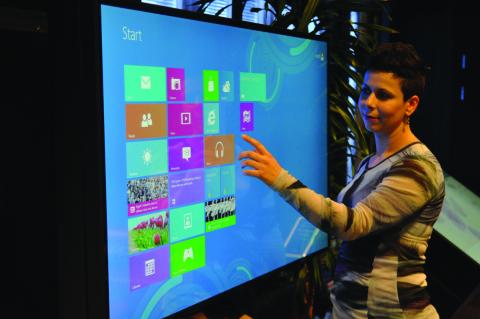In late November, interactive digital signage developer MultiTouch launched what it calls “the first large-format displays with a built-in touch user interface,” integrating with Microsoft’s new Windows 8 operating system (OS) and Intel’s Core i7 processor. The 1- and 1.4-m (42- and 55-in.) displays—intended primarily for the retail, education, real estate and corporate markets, in public spaces and exhibitions—are also reportedly the first interactive screens to support the simultaneous use of multiple touches, Windows 8 native pen tracking and object-based interaction. This means users can manipulate on-screen content through multiple input methods, including fingers, hands, pens and Enriched Reality (ER) systems. Between these functions and the ability to run standard Windows 8 applications, the displays are larger incarnations of the same technology already commonly seen in smart phones and tablet, notebook and desktop computers. Application developers can use industry-standard platforms and interfaces, including Extensible Markup Language (XML) streams and the Table-Top User Interfaces Objects (TUIO) protocol. “Touch interface is the way of the future for consumers and businesses,” says Petri Martikainen, CEO of MultiTouch, which is headquartered in Helsinki, Finland. “With the OS running across multiple devices, we will see the number of interactive applications grow exponentially.” This trend is helping interactive digital signage mesh more closely with mainstream technologies. While liquid crystal displays (LCDs) with fully integrated touch capabilities are still a recent phenomenon, they have already reached the majority of Canadian consumers, particularly in the form of smart phones. “There is now a huge installed user base carrying touch screens around all day,” says Ian Kimball, 3M Touch’s marketing manager for the Americas. “The Apple iPad has also impacted digital signage in terms of industrial design. It all started at a small size and now we want the displays to feel the same and deliver an equal experience at a larger size.” Kimball, whose team is part of 3M’s Electro and Communications Business (ECB), says there is much opportunity yet for greater interactivity in digital signage applications, especially in the retail sector. “People’s appetite to interact with this technology is high,” he says, “and they don’t usually need instructions to do so. They’ve come to expect touch. Meanwhile, retailers want to make their stores more experiential, not just transactional. The content needs to entice customers to the point-of-purchase (POP) area. A lot of brand owners are using moving video to create excitement in the store and then, once you’re there, you can interact with multimedia content and learn more about their products.” That said, the technology has also made its way into kiosks, directories, wayfinding systems and even video walls. “It’s already gotten to the point where you’re seeing a ‘do not touch’ sign posted next to non-interactive screens!” says Kimball.






